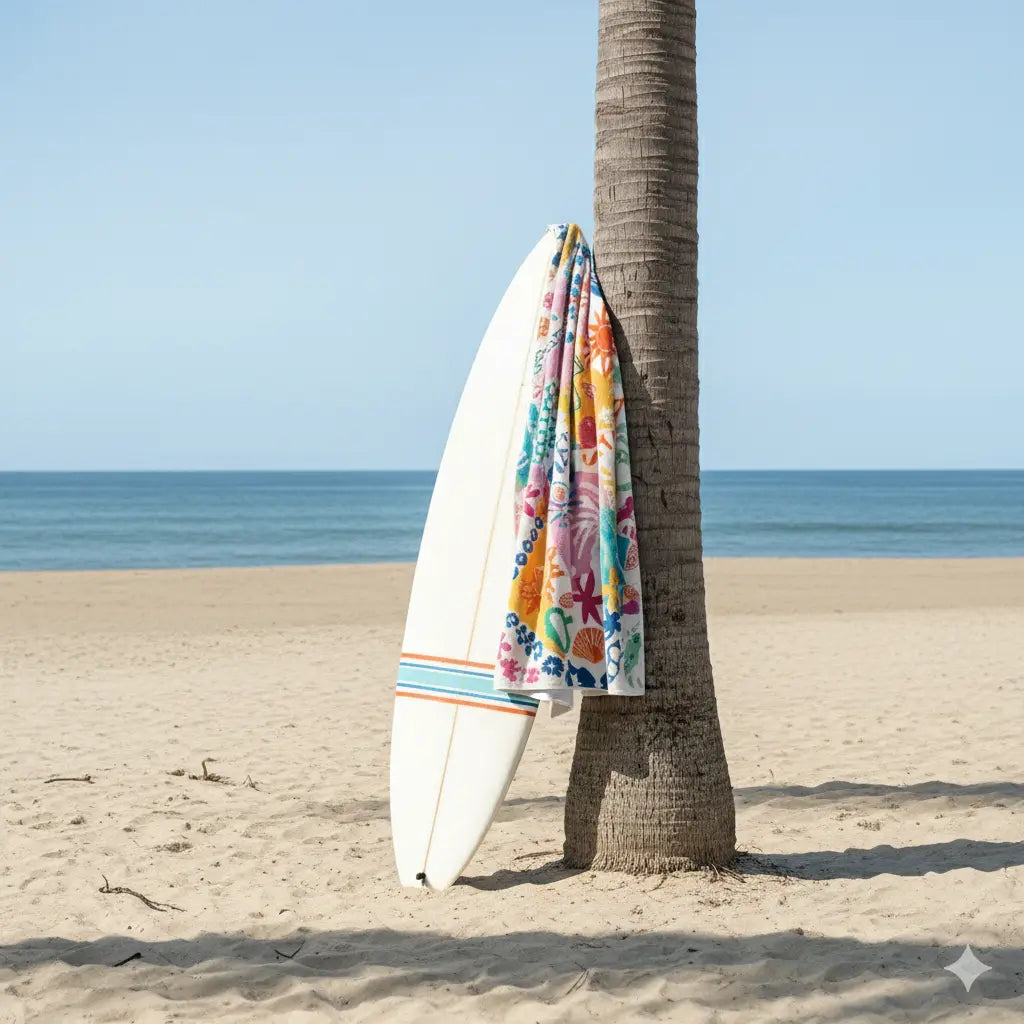Microfibre vs Cotton: Which Beach Towel is Better for Travel?
If you’ve ever packed a heavy cotton towel in your suitcase only to find it still damp two days later, you’re not alone. Travellers are swapping bulky cotton for lightweight microfibre towels that dry in minutes and barely take up space. But does that mean microfibre always wins? Let’s break down the pros and cons of each fabric so you can decide which beach towel is truly best for your next trip.
Quick Takeaways
-
Cotton towels feel plush but are heavy, slow to dry, and trap sand.
-
Microfibre towels are light, fast-drying, and naturally repel sand.
-
The best travel towels combine softness, absorbency, and compact design.
-
Sand free beach towels made from premium microfibre perform best for travellers.
-
A beach towel with pocket or zipper pocket adds security and practicality for travel.
The Basics: Cotton vs Microfibre
Most people grew up using cotton towels. They’re soft, familiar, and thick — perfect for home bathrooms but not so great for travel. Cotton holds a lot of water, meaning it takes hours (sometimes a full day) to dry. It’s also heavy when wet and traps sand easily, which makes it less than ideal for beaches or backpacks.
Microfibre, on the other hand, is a technical fabric made from very fine synthetic fibres — usually a blend of polyester and polyamide. It’s designed to be light, compact, and incredibly quick-drying. That’s why you’ll find it in travel towels, sand free beach towels, and sports gear.
The difference isn’t just about material — it’s about performance. A microfibre towel can hold up to three times its weight in water and still dry within an hour, while cotton towels take much longer and often stay damp in humid conditions.

Comparison Table: Cotton vs Microfibre Beach Towels
| Feature | Cotton Beach Towel | Microfibre Beach Towel |
|---|---|---|
| Drying Time | 6–12 hours | 30–60 minutes |
| Absorbency | High but heavy | High and lightweight |
| Sand Resistance | Low – sand sticks | High – sand slides off |
| Weight | Heavy when wet | Light, even when wet |
| Packability | Bulky | Compact |
| Odour Resistance | Can hold damp smell | Dries fast, no mustiness |
| Travel Friendly | Not ideal | Perfect for travel |
Why Microfibre Towels Are a Game-Changer for Travellers
The biggest appeal of a microfibre towel is practicality. When you’re travelling, space and drying time matter. You don’t want to hang a heavy cotton towel from your hostel bunk all night and still pack it damp the next morning.
Here’s why travellers (and beachgoers) are making the switch:
1. Compact and Lightweight
Microfibre towels fold down small enough to fit in your hand luggage or backpack. They’re ideal for minimalist travellers, van life, or anyone hopping between beaches and hotels.
2. Sand Free and Easy to Shake Off
A sand free beach towel made from microfibre has a tight weave that prevents grains from sticking, so you can leave the beach at the beach.
3. Fast Drying and Odour-Free
Even after a swim, microfibre towels dry in about 30–60 minutes. That means no damp smells or mildew building up in your bag.
4. Multi-Purpose Use
Travellers love them because they double as a blanket, yoga mat, sarong, or picnic rug. They’re the kind of travel essential you end up using every day.
5. Hidden Pockets for Convenience
Premium versions, like a beach towel with pocket or beach towel with zipper pocket, add a secure place for keys, cash, or cards — perfect if you’re swimming solo or don’t want to carry a bag.

When Cotton Still Wins
Cotton towels aren’t obsolete — they’re just suited to different needs. If you love the thick, spa-like feel of plush fabric and you’re mostly using it at home or near a washing line, cotton still delivers on comfort.
Some people prefer that heavier texture, and cotton can feel slightly warmer if you’re using it to lie on during cooler beach days. But for practical use — especially for travel or wet conditions — it’s hard to beat microfibre.
Environmental Impact: Which Is Better?
This part’s a little more complex.
Cotton is a natural fibre, which sounds more eco-friendly at first glance, but it’s one of the most water-intensive crops in the world. Growing and dyeing cotton uses massive amounts of water and chemicals.
Microfibre is synthetic, made from plastics, but modern brands are now producing recycled microfibre towels using regenerated materials from post-consumer waste. The key is buying from brands that focus on responsible production and quality, so the towel lasts longer and reduces waste.
Nomadique Co, for instance, uses premium recycled microfibre that’s designed to perform better, last longer, and stay out of landfill. A durable product that replaces dozens of cheap towels over the years is the most sustainable option of all.
How to Choose Between Microfibre and Cotton
If you’re still torn, here’s a quick way to decide:
Choose Microfibre If You:
-
Travel often or live on the go
-
Want something lightweight and compact
-
Hate waiting for towels to dry
-
Need a sand free beach towel
-
Prefer quick-dry, odour-resistant materials
Choose Cotton If You:
-
Mostly use your towel at home
-
Love that plush, traditional feel
-
Don’t mind slower drying times
-
Have plenty of luggage space
For most modern travellers, microfibre wins hands down. It’s simply built for convenience, comfort, and everyday practicality.
FAQ: Microfibre vs Cotton Beach Towels
Do microfibre towels actually absorb water well?
Yes. Despite being thinner, microfibre absorbs up to three times its weight in water and dries much faster than cotton.
Do they feel different?
They do — microfibre feels smooth rather than fluffy, but high-quality ones are soft and comfortable against the skin.
Do microfibre towels get smelly?
No, because they dry so quickly that bacteria and odours don’t have time to build up.
Are all microfibre towels sand free?
Not automatically. Only those with a tightly woven surface (like Nomadique’s sand free beach towel) effectively repel sand.
Can you machine wash microfibre towels?
Yes — wash cold, avoid fabric softeners, and air dry for best results.

Nomadique Co’s Take
At Nomadique Co, we design towels for real travel and beach life — not just for looks. Our sand free beach towel is made from premium recycled microfibre, built to stay soft, dry fast, and shake off every grain of sand.
Each towel includes a hidden zipper pocket, perfect for stashing your phone or keys while you swim, and a hanging loop for quick drying. It’s the perfect balance of performance, comfort, and sustainability — ideal for travellers who want less bulk and more freedom.
If you’re choosing between cotton and microfibre, think about where and how you’ll use it. For travellers, adventurers, and beach regulars, a microfibre towel is simply the smarter choice.

References & Sources
-
Textile Exchange Report 2025 – Sustainable Fabric Comparison
-
EcoTourism Australia – “Travel Essentials for Low-Impact Packing”
-
Nomadique Co Product Research and Customer Reviews




Leave a comment
This site is protected by hCaptcha and the hCaptcha Privacy Policy and Terms of Service apply.